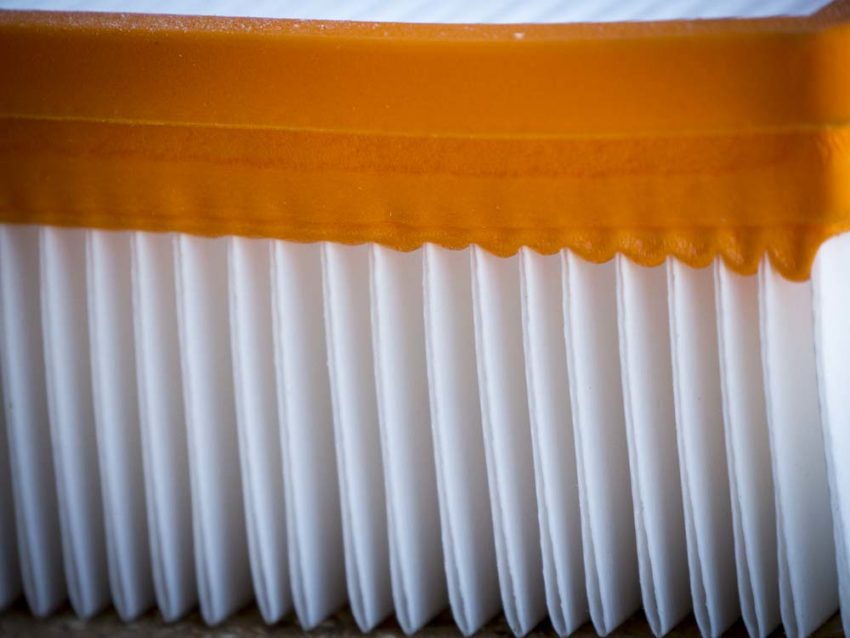Everyone knows that using a HEPA filter is the way to go, right? But do you really need a HEPA filter at all times? After gathering information from several manufacturers, we’re going to make the case both for and against using them in various situations. Think we’re crazy for ever staying away from a HEPA filter? That’s okay. Hopefully, we can persuade you of our reasoning by the time we get to the end of the article.
Table of Contents
What Does HEPA Stand For?
HEPA stands for High-Efficiency Particulate Air. Therefore, a HEPA filter removes particulates from the air with greater efficiency than traditional filters. Greater efficiency refers to removing smaller particles while not prohibitively reducing airflow so as to affect the work of the tool or machine.
What is a HEPA Filter?
Before we talk about the issue of whether you need a HEPA filter, it might help to explain it. Here’s the 30-second breakdown:
- HEPA filters use a mesh design with finer filtering than other filters
- They capture 99.97% of all particles 0.3 microns or larger
- They trap things like concrete dust, pollen, dander, and other small particulates that many people don’t want to breathe
- You’ll find them in dust extractors, vacuums, HVAC systems, and more where trapping the most particles possible is key
HEPA Filters and Personal Safety
One thing we want to make clear regarding the use of these better filters concerns scale. The difference between 2 microns (µm) and 0.03 microns (PM0.3) is the difference between capturing mold spores and stopping suspended dust particles.
Believe it or not, cement dust falls to the higher end of the scale—often larger than 3 microns in size. So when we prioritize higher suction power and a less effective filter over a HEPA filter and reduced suction—we do so with an attempt to increase your health, not hurt it.
The Case FOR HEPA Filters
The case for the use of HEPA filters is straightforward. Since they remove more particulates, HEPA filters—by the numbers—do more to keep harmful dust and concrete particles out of your lungs.
For professionals, you also need to follow the rules associated with Table 1 compliance and similar OSHA regulations.
If you just want HEPA to capture those smaller particles—regardless of whether OSHA requires it, we get it. Just make sure that the vacuum system works efficiently with the HEPA filter in place. As mentioned below, cyclonic systems perhaps do this best.
Don’t think that sacrificing suction for HEPA filtration is always a good trade-off. If the filter clogs or dust starts escaping around your saw or grinder, you may find yourself inhaling more dust than if you had better suction with a regular filter in place.
The Case AGAINST HEPA Filters
The case against using HEPA surrounds its design. The characteristics that make it so good at trapping particles also hinder it in many vacuum systems. Depending on the work you’re doing, sometimes:
- The vacuum or dust extractor strains and provides far less suction with a HEPA filter installed, or
- You simply don’t need that level of filtration
Take your typical cellulose (paper) filter. You get 99.9% trapping of particles 2 microns or larger. That’s a pretty close trapping percentage (just 0.07% less effective). However, particles nearly 7x as big can pass right through. We’re still just talking 2 microns, though. That’s 1/500 of a millimeter. What fits in that size range, you ask?
- Mold spores
- Pollen
- Settling and heavier dust
- Cement dust (that may surprise some)
- Many kinds of bacteria

Airflow Matters
The extra space in the filter does more than just let somewhat larger particles through. It also allows more air to pass. Because of that, going with a regular filter increases the performance of some vacuums or dust extractors more than if you use a HEPA filter.
Here’s the other thing, because these filters trap more, they also clog more quickly. That means you’ll see performance drop more quickly and have to replace it more often.
Editor’s Note: Cyclonic filtration systems like those used in the iQ Power dust extractor avoid bogging down the HEPA filter with larger particles. These systems really optimize the filters and stay running at optimal suction for much longer. You can also help yourself by using a pre-filter or dust collector.
Finally, you may want to factor in cost—however, that’s pretty low on our totem pole of priorities. Many HEPA filters can cost upwards of $79 or more. You can often buy three cellulose filters for every HEPA filter you buy and still have $10 left over to take your wife out for ice cream. That’s a win.
When You Need a HEPA Filter for Table 1 Compliance
When in doubt, follow the OSHA guidelines and mind the capabilities of your tools. There are absolutely applications when you need a HEPA filter on site. It just might not be as often as you expect.
Pro Tip: No matter what you’re using, but especially when using HEPA, also use a fleece collection bag. It acts as a pre-filter and extends the life of your filter.
The Bottom Line
HEPA filters are better at trapping particles than standard ones and capture much more. For general concrete dust, however, it may not matter. The trade-off is that your performance can suffer. If your dust collector bogs down more rapidly and you muscle through it, you may be breathing more particulates than you think.
HEPA filters also cost more and need more frequent replacement. So use them when required, but avoid them if they aren’t called for and you think you might lose suction on your dust extractor. Keeping that system running more efficiently matters more than you might think.




